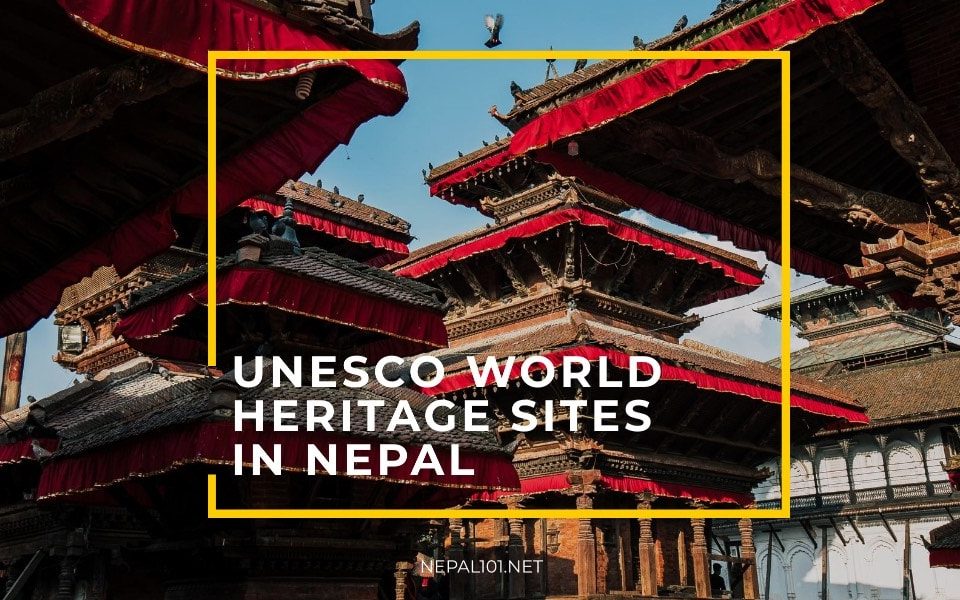Nepal, although mostly known for the highest mountains in the world, also hosts many heritage sites listed in UNESCO World Heritage sites of the world.
The UNESCO heritage sites are places of cultural and natural importance. Nepal has 4 heritages sites – 2 are natural heritage sites and 2 are cultural heritage sites. Kathmandu Valley is a cultural heritage sites that includes many sub-sites.
These heritage sites are a major attraction for travelers visiting Nepal. Each heritage site charges a nominal entrance fee. The revenue from the entrance fee helps conserve, maintain and develop the sites.
Following are the top 10 UNESCO world heritage sites to visit in Nepal with their cultural significance and the cost of entrance. –
1. Kathmandu Durbar Square

Kathmandu Durbar Square is one of the three magnificent Durbar Squares (Palace Square) of Kathmandu Valley.
Also known as the Hanuman Dhoka Durbar Square or Basantapur, it is one of the major attraction of Kathmandu valley. Kathmandu Durbar Square is known for its traditional Nepali architecture, showcasing Newari artists and artisans’ over several centuries.
Besides the historical buildings, Hanuman Dhoka is the main location where festivities such as Jatras takes place. People have observed Nepali traditions and festivals like Indrajatra, Dashain, Gaijatra, Machhindranath Jatra in Hanuman Dhoka. The Taleju temple, Kal bhairav temple, Indrapur temple, Vishnu temple, Kotilingeshwara Mahadev temple are few of the most visited temples in the durbar square area.
Most importantly, the living Goddess Kumari’s temple is also inside the Kathmandu Durbar Square. Navigating the Durbar Square area with a local guide helps you understand the significance of the buildings, traditions and cultural practices that takes place inside.
Several ancient buildings of the Durbar Square collapsed during the earthquake of 25 April 2015. However, there is a massive rebuilding project focusing on the restoration of the durbar square.
Kathmandu Durbar Square entrance fee
Regular entrance fee: NPR 1,000
SAARC nationals: NPR 150
2. Boudhanath Stupa

Boudhanath stupa is one of the largest stupas in the world. It is also one of the oldest religious sites in Kathmandu. The stupa has Buddha’s eyes and eyebrows painted on it. In between the eyes, the Devanagari number ‘one’ is painted, symbolizing a nose. Most importantly, the pilgrims believe that the Boudhanath Stupa houses the remains of lord Buddha himself.
Tibetan traders have rested and offered their prayers in the stupa for many years. It is an important place for meditation and pilgrimage for Buddhists around the world. The Mughal invaders wrecked the first Stupa in the 14th century, so the current stupa is a more recent re-construction.
Many people walk four to five times around the stupa clockwise, repeating the mantra ‘OM MANI PADME HUM’ daily.
Boudhanath Stupa entrance fee
Regular entrance fee: NPR 400
SAARC nationals: NPR 100
3. Changu Narayan Temple

The temple of Changu Narayan is one of the oldest Hindu temple in Nepal. It is located on a hill around 14 kms east of Kathmandu Valley.
It is a two-storied pagoda style temple dedicated to Lord Vishnu (also known as “Narayan”). Moreover, the ancient carvings on the temple pillars and statues make the temple uniquely remarkable. Apart from the temple itself, some of the decorative ornaments are one of the oldest in Nepal. The temple has four entrances guarded by a life-sized pair of animals like elephants, lions, and sarabha.
In 1702, a big fire swept through the temple area destroying many elements of the temple. However, presently the temple gets plenty of visitors and remains well maintained.
The Manohara River flows beside the hill and travelers can hike from Bhaktapur to Changu Narayan temple or drive to the temple.
Changu Narayan Temple entrance fee
Regular entrance fee: NPR 300
SAARC nationals: NPR 100
4. Pashupatinath Temple

Pashupatinath is not only a religious destination but also a nexus of Hindu religion, art, and culture. Thousands of Hindu pilgrims from various parts of the world visit Pashupatinath annually during the Maha Shivaratri festival to worship Lord Shiva.
The temple lies in the eastern part of Kathmandu – 5 km away from central Kathmandu. The temple complex was inscribed in the UNESCO World Heritage Sites’ list in 1979. It is one of the 275-Tamil Paadal Petra Sthalams on the continent.
The temple premises showcases a variety of temple designs and considered an important destination for art historians. The sculptures in the temple premises are made from wood, stone, and metal carvings. There are many famous temples inside the Pashupatinath area, including the Paachdewal, Bishwarupa, Dakshinamurti, Tamreshwor, Bhuwaneshwori, and others.
The worshippers and devotees perform various rituals in Pashupatinath temple. Furthermore, Pashupatinath is a center for Hindu cremation ceremonies too.
The best time to visit the temple is an hour before the Pashupati aarati. This way you can catch a glimpse of the ultimate reality – the Hindu cremation ceremony and aarati. The aarati takes place at the bank of Bagmati River in the evenings at around 6.30 pm to 7.30 pm.
Pashupatinath Temple entrance fee
Regular entrance fee: NPR 1,000
SAARC nationals: NPR 1,000 (Free for Indian Citizens)
5. Bhaktapur Durbar Square

Bhaktapur Durbar Square, the royal palace of the old Bhaktapur Kingdom, is located in the current town of Bhaktapur.
It lies around 13 km east of Kathmandu. The Durbar Square houses the 55-window palace constructed by King Jitamitra Malla and was home to the royals until 1769. Many of the smaller streets converge onto the square where the Bhaktapur Kingdom’s royal palace was located.
Nyatapola (five stories) is another major attractions around the Bhaktapur Durbar Square. Batsala temple, Statue of Bhupatindra Malla, Bhairav Temple, Golden Gate, Lion’s Gate, Mini Pashupatinath temple are other main attractions of Bhaktapur Durbar Square.
Tony Hangen museum house and Namuna Ghar are newer places to visit in the Durbar Square area.
Most importantly, the Bhaktapur Durbar Square area has the tastiest yogurt – Juju Dhau. We highly recommend getting a serving of the special Juju Dhau while visiting Bhaktapur Durbar Square.
Bhaktapur Durbar Square entrance fees
Regular entrance fee: NPR 1,500
For SAARC nationals: NPR 500
6. Swayambhunath Stupa

Swayambhunath temple also known as the monkey temple is one of the cultural heritage sites of Nepal. It is in the Kathmandu valley around 15 – 20 minutes away from Thamel. Reaching Swayambhunath consists of climbing 365 stairs and rewards you with a panoramic view of the Kathmandu Valley.
The central buildings and decorations of this holy site are rich with Buddhist symbolism, and a cubical structure painted with the eyes of Buddha in all four directions represents wisdom and compassion.
Many statues of Buddha are placed in the temple and is the center of tourist attraction. It is undoubtedly one of the most sacred places for Buddhist pilgrims and only second to Boudhanath Stupa.
The Swoyambhunath area is filled with temples, chaityas, painted deities, and other religious objects. It is also called the ‘Monkey Temple’ because hundreds of monkeys keep lurking around the stupa.
Swayambhunath Stupa entrance fees
Regular entrance fee NPR 200
For SAARC nationals: NPR 50
7. Patan Durbar Square

Patan Durbar Square is located on the grounds of Lalitpur city (Patan) of Nepal. The Durbar Square premises is a visual display of Newari architecture in Nepal.
Furthermore, Patan is one of the oldest Buddhist cities and is a center for Hinduism and Buddhism, with 136 Bahals and 55 major temples carrying its own culture, norms, and tradition.
The Patan museum is one of the biggest attractions of Patan Durbar Square because it is filled with bronze statues and religious objects. The Krishna temple is the most important temple in the square. Golden temple, Bhimsen temple, Vishwanath temple, Taleju Bhawani temple are some of the popular temples to explore in Patan.
The old temples and monuments are a classic example of Nepali architects and showcases various eras of architecture and design. It consists of many architects, which were changed by the Malla Kings reflecting its beauty, and because of its beautiful temple architect, it is a center of tourist attraction.
Patan Durbar Square entrance fees
Regular entrance fee: NPR 1,000
For SAARC nationals: NPR 250
8. Lumbini

The birthplace of Gautam Buddha, which soon became a place of pilgrimage, Lumbini, is located at Rupandehi District in Province 5.
It consists of older temples funded by Buddhist organizations from various countries that have been completed or are still under construction. Lumbini is one of the holiest places of one of the world’s great religions.
Regardless of faith, visitors find that it is the atmosphere that creates peacefulness and possesses special spiritual energy. There are many monuments, monasteries, and museums to visit, such as Ashoka Pillar, Mayadevi temple, World Peace Pagoda, Myanmar Golden Temple, the Lumbini International Research Institute, etc.
Lumbini entrance fees
Regular entrance fee: NPR 200
For SAARC nationals: NPR 100
9. Sagarmatha National Park

The country’s first National Park inscribed as a Natural World Heritage Site declared by UNESCO in 1979 AD, Sagarmatha National Park, was established in 1976 AD.
It covers 1,148 sq. kilometers in the Northern mountain of Khumbu region of Province No. 1 of Eastern Nepal.
The area includes the Dudhkoshi and Bhotekoshi rivers, the Himalayas ranging from 2,845 meters to the world’s tallest mountains, also the glaciers and deep valleys. Endangered species such as snow leopard, musk deer, red panda, and more than 1,000 floral species can be found in the national park area. The presence of Sherpas with their unique culture add more sparks to this park.
Sagarmatha National Park is one of the most visited places in Nepal because of the popularity of the best trekking routes in Nepal. Treks to the Everest Base Camp, Three Passes, Gokyo, Meera peak etc takes place in the Sagarmatha National Park area.
Sagarmatha National Park entrance fees
Regular entrance fee: NPR 3,000
For SAARC nationals: NPR 1,500
10. Chitwan National Park

Chitwan National Park is the first national park of Nepal. It covers 952.63 sq. kilometers (367.81 sq. miles) and is located in the Southern Central Terai of Nepal. It extends over four districts: Chitwan, Nawalparasi, Parsa, and Makawanpur.
In 1996, an area of 75,000 hectares consisting of forests and private lands and surrounding the park was declared a buffer zone. It is a magnificent example of biological evolution with a unique assemblage of native flora and fauna from the Siwalik and inner Terai ecosystems.
Nepal’s government has made provision to provide 30 to 50 percent of the National Park’s returns for natural resource management and community development in the buffer zone.
Travelers go to Chitwan National Park to not only get close to the green nature but also to witness animals such as the one horned rhinoceros, Asia elephants and royal bengal tigers.
Chitwan National Park entrance fees
Regular entrance fee: NPR 1,500 per day per entry + 13% VAT
For SAARC nationals: NPR 750 per day per entry + 13% VAT
Summary
The heritage sites mentioned above have a great significance in the modern world in the travel and tourism sector and are among the main sources of the country’s economy for generating revenue and job generation.
They also provide a better understanding of the sense of unity and belongings of the previous generation and the history where we come from.
The above heritages gives Nepal its unique identity in a global landscape.






